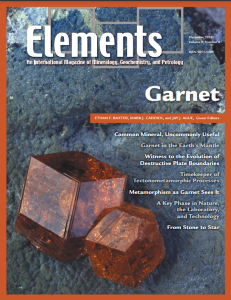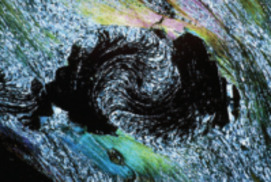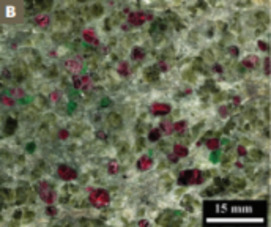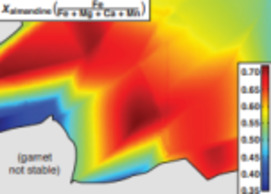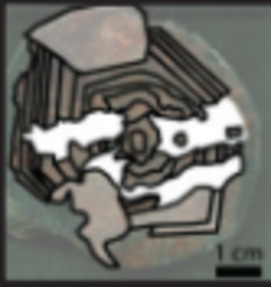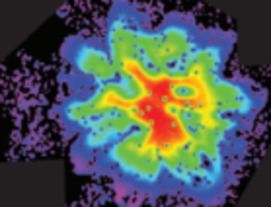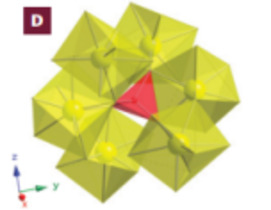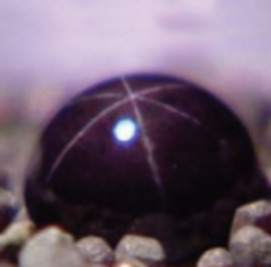
Garnet: Common Mineral, Uncommonly Useful
Ethan F. Baxter, Mark J. Caddick, and Jay J. Ague – Guest Editors
Table of Contents
Garnet is among the most studied—and most beloved—minerals, owing to its commonality in diverse geologic contexts, its often large euhedral crystals, its sometimes dazzling colors, and its propensity for preserving information about its growth history. Chemically zoned garnet represents a remarkable tool for deciphering metamorphic conditions and the evolving tectonic processes that drive garnet growth over many millions of years. In the deep Earth, garnet is a key rock-forming mineral, influencing the physical properties of the mantle and the composition of mantle-derived magmas. Garnet has been sought for ages as a semiprecious gemstone (the birthstone of January) and has been mined or synthesized (including nonsilicate garnet) for industrial purposes, including laser, magnetic, and ion-conductor technology. This issue of Elements will emphasize the most recent innovations in thermodynamic, geochemical, geochrono- logic, and industrial applications of garnet, while providing perspective on decades of garnet-related research.
- Garnet: Common Mineral, Uncommonly Useful
- Garnet in the Earth’s Mantle
- Garnet: Witness to the Evolution of Destructive Plate Boundaries
- Garnet Geochronology: Timekeeper of Tectonometamorphic Processes
- Metamorphism as Garnet Sees It: The Kinetics of Nucleation and Growth, Equilibration, and Diffusional Relaxation
- Garnet: A Key Phase in Nature, the Laboratory, and Technology
- Garnet: From Stone to Star
Bruker
Bruker Nano
Cameca
FEI
Excalibur Mineral Corporation
Geochemist’s Workbench
Geological Society of London
IUMAS meeting
JEOL
McCrone Microscope and Accessories
Rigaku
Savillex
SPECTRO
TSI
v10n1 GARNET: ASTEROIDS: LINKING METEORITES AND PLANETS
Guest Editors: Catherine Corrigan (Smithsonian Institution, Washington) and Guy Libourel (Observatoire de la Côte d’Azur, Nice, and CRPG, Université de Lorraine)
Asteroids number in the millions. Orbiting the Sun between Mars and Jupiter, they are thought to be the shattered remnants of small bodies formed within the young Sun’s solar nebula and that never accreted large enough to become planets. By presenting several case studies, this issue will present what we know about the physical and chemical compositions of asteroids and how they are related to meteorites and planet formation. We will show why these “minor bodies” are key to understanding how the Solar System formed and how it works; why they are clues to the origin of life, having possibly delivered organics and water to Earth; and why the international space agencies have funded sample-return missions to asteroids.
- Asteroids: New Challenges, New Targets Guy Libourel (Observatoire de la Côte d’Azur, Nice) and Catherine M. Corrigan (Unknown)
- Formation and Physical Properties of Asteroids Patrick Michel (Observatoire de la Côte d’Azur, Nice)
- Establishing Asteroid–Meteorite Links Edward A. Cloutis (University of Winnipeg), Richard P. Binzel (Massachusetts Institute of Technology), and Michael J. Gaffey (University of North Dakota)
- Asteroid 2008 TC3 and the Fall of Almahata Sitta, a Unique Meteorite Breccia Cyrena Goodrich (Planetary Science Institute, Tucson), Addi Bischoff (University of Münster), and David P. O’Brien (Planetary Science Institute, Tucson)
- Unique, Antique Vesta Harry Y. McSween (University of Tennessee), Maria Cristina De Sanctis (Institute for Space Astrophysics and Planetology, Italy), Thomas H. Prettyman (Planetary Science Institute, Tucson), and the Dawn Science Team (Unknown)
- Asteroid Itokawa A Source of Ordinary Chondrites and A Laboratory for Surface Processes Akira Tsuchiyama (Kyoto University)
- One Hundred Years of Geochronology (February 2013)
- Serpentinites (April 2013)
- The Mineral-Water Interface (June)
- Continental Crust at Mantle Depths (August 2013)
- Nitrogen and Its (Biogeocosmo)Chemical Cycling (October 2013)
- Garnet: Common Mineral, Uncommonly Useful (December 2013)
Download 2013 Thematic Preview
- Asteroids: Linking Meteorites and Planets (February 2014)
- Ophiolites (April 2014)
- Kaolin (June 2014)
- Unconventional Hydrocarbons (August 2014)
- Cosmogenic Nuclides (October 2014)
- Graphitic Carbon (December 2014)
Download 2015 Thematic Preview


